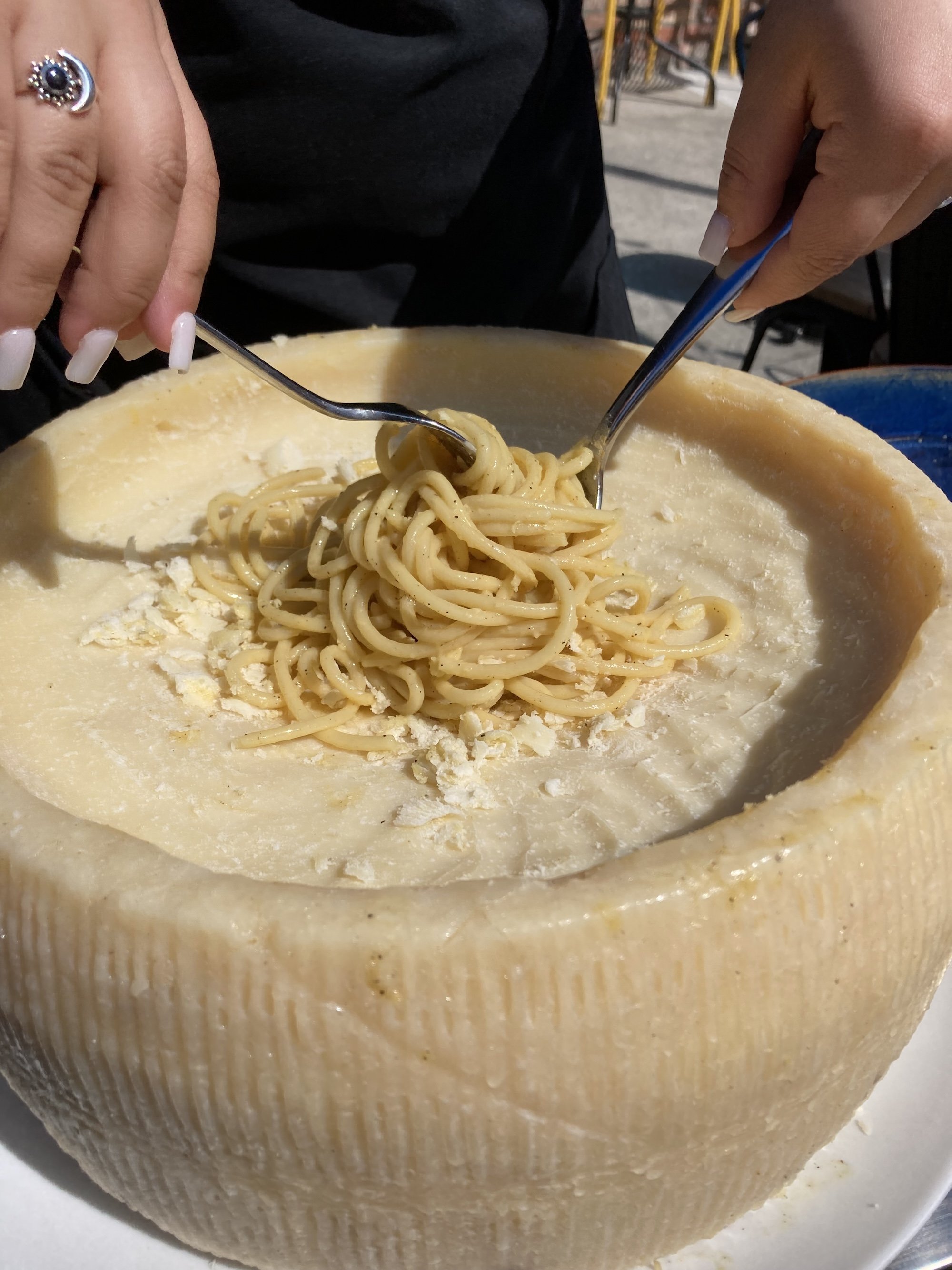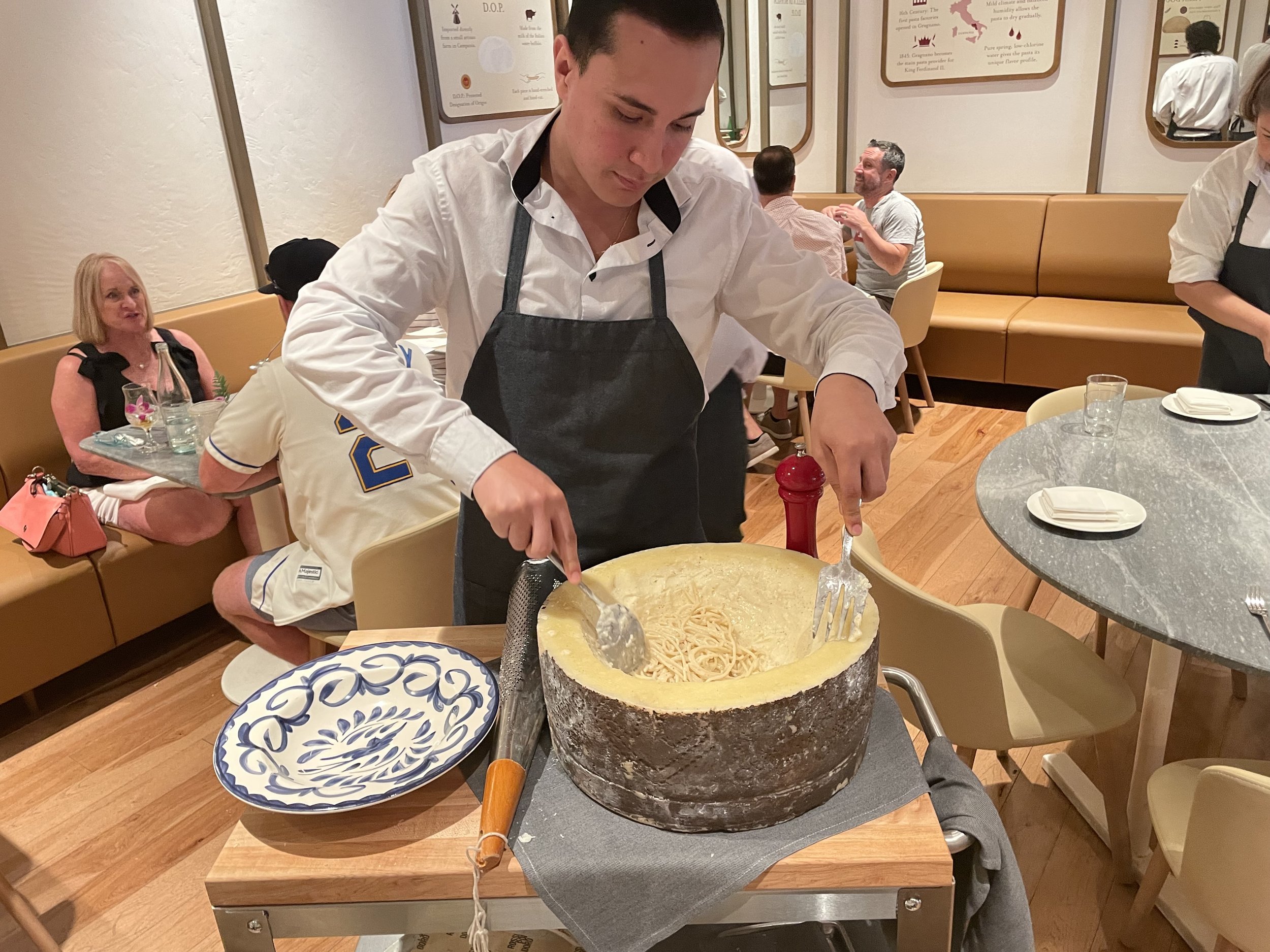What is Pasta alla Ruota & Why is Everyone So Crazy About It?
Pasta alla Ruota
Who knows how cheese trends start? There was a time when fondue parties were all the rage, pizza ovens seemed to appear in every backyard and now wedge salads with blue cheese are back in style. Whatever the reason, the universe is colluding to make Italian pasta alla ruota the dish on everyone’s lips. It’s a simple recipe, piping hot pasta is placed in a hollowed-out cheese wheel, then a chef or waiter scrapes the sides of the cheese wheel bowl, so every single piece of pasta is coated in fresh cheese. A showstopper dish often served tableside, the TikTok hashtag #cheesewheelpasta has 232.8M views so it’s no wonder that diners are clamoring for it.
“Although it’s a little gimmicky, it’s not only a great way to use up every morsel of the Parmigiano Reggiano wheel, but also downright delicious, says Laura Werlin, the award-winning author and cheese educator known as cheezelady. Read more about Laura Werlin. Viola Buitoni, Italian cooking instructor and author of Italy by Ingredient - Artisanal Foods/Modern Recipes was raised in Perugia, Italy and laughs that “A couple of places, both in the U.S., claim to be the birthplace of it, but in reality, the technique originates in Italy as a translation of a risotto technique. I remember first seeing pasta cooked this way in the early 90’s. Both Veneto and Lombardia lay claim to having started it.”
What is Pasta Alla Ruota?
Also known as cheese wheel pasta, Buitoni says only Americans call it pasta alla ruota. In Italy she says”...it’s referred to by the method with which it is made, pasta mantecata nella forma di Parmigiana. She explains that”...the U.S. name makes sense, as the word for a whole wheel of cheese in Italian isn’t the corresponding “ruota,” it is “forma.” Thus, I suspect that the name pasta alla ruota originated as a direct translation of pasta in the wheel.”
She understands its appeal. “The super, super hot pasta is placed in the wheel with a little cooking water around it, and as the pasta is twirled and swirled, the starch in the water binds into a velvety gossamer with the fat in the cheese around the strands of pasta,” she says. “I do think it adds to the pasta. It is for sure quite scenic and always gets ooohs and aaahs from diners.” She says it is not often found in restaurants in Italy. “One does see it there, but generally it’s found in convivial settings, like, say, a wedding.”
Buitoni says she’s seeing the transition from risotto to pasta gaining in popularity. “My personal theory is that Eataly has given it visibility by introducing the cacio e pepe (pasta with pepper) version in the Pecorino wheel in its restaurants.”
Pasta alla Ruota in America
Pasta alla ruota at Eataly Silicon Valley
Eataly’s global vice president, Dino Borri, says since 2010 when they opened in the U.S., they’ve been offering many dishes in cheese wheels, depending on the seasonality. “We’ve done everything from the spaghetti cacio e pepe to risotto with truffles in a wheel of Parmigiano Reggiano to the classic Roman pasta, amatriciana.”
“Opening up a cheese wheel is something we always do at Eataly for seasonal events and demonstrations in-store, since it is a true icon for us,” says Borri. “Of course, once guests see the wheel in front of them, they are going to want to indulge. Often times we do prepare it tableside as an added experience for our customers. Recently cacio e pepe was served tableside from a wheel of cheese at La Pizza & La Pasta restaurant in the Eataly Silicon Valley during their first year anniversary. As neighboring diners saw it, they couldn’t help but order it too.
Cacio e pepe at Eataly
At Eataly he says there isn’t a set number of times that a cheese wheel can be used. “It depends on what dish you will be serving and how many people you have. That said, you can’t use it too many times.”
Eataly has a spectacular selection of Italian cheeses, and they open cheese wheels at events, cooking classes, in the grocery section and in restaurant dishes. “Once our cheese mongers open a wheel of Parmigiano Reggiano, or any other hard cheese, and most of the cheese is consumed or cut for retail purposes, the last of it is used up by creating unique dishes in our restaurants, so nothing goes to waste.” He is proud to serve DOP cheeses which stand for Denominazione di Origine Protetta, the protected destination of origin, guaranteeing the products are made according to strict regulations to ensure their authenticity and quality. Two of the most popular cheeses for the dish, Parmigiano Reggiano and Pecorino Romano are DOP cheeses. Read more about Parmigiano Reggiano and all the DOP Pecorino cheeses.
Buitoni has a great tip for those who’d rather create the dish at home. “If you’re interested in trying the trend for a party or a large crowd, of course, you can speak with your local cheese monger and see if they can provide the hollowed-out wheel that might have been otherwise discarded.”
Mario Sabatini, co-owner and general manager of Forma Venice says after he started preparing this style of pasta at his first restaurant, Pecorino in Los Angeles, it suddenly became very popular all over the city. He almost pulled the simplest dish, cacio e pepe served in a Pecorino Romano cheese wheel, from the menu until the Los Angeles Times food critic wrote a favorable review in 2005. Because of the cheese wheel success, he built his new restaurant, Forma, around this concept. The most popular dish? Cacio e pepe. A simple dish, but not easy to make, the only ingredients are the pasta, “cacio,” which is the spicy Pecorino Romano, “pepe,” which is pepper and water. Combining them seemingly by magic into something luscious and smooth is the secret to the popularity of the dish.
Forma calls their preparation of the dish “dalla forma,” and makes several versions including chitarra cacio e pepe tossed in Pecorino Romano, malfalde carbonara served from a Pecorino Romano bowl, fettuccine Bolognese tossed in Parmigiano Reggiano, and tortellini with mushrooms served in Bella Lodi cheese, a hard cheese with a black rind cheese, also known as black parmigiano. Modern interpretations of classic Italian dishes, says Sabatini, “In Bologna, where Bolognaise is from, they don’t mix sauce with pasta – it’s served on top.” In addition to the pasta, they also serve a traditional risotto dish out of a Grana Padano cheese wheel.
Forma Venice’s technique involves opening the cheese wheels by eliminating the rind (only on top) and after the pasta is cooked in boiling water and sautéed with olive oil and black pepper in the pan it’s tossed into the cheese wheel. Scraping the cheese from the wheel makes a difference since” ...kitchens use grated cheese, and it dries up-if you scrape the cheese from the wheel, it’s fresher.”
A big wheel of cheese at his restaurant can serve 3 or 4 pastas at a time depending on order. (When he uses veal, he does not re-use the wheel). The Parmigiana wheels weigh 80 pounds -and the Pecorino 40 pounds, so he can serve about 250 pastas per cheese wheel.
But sometimes the pasta is put into different forms of cheese. “The name “forma” which translates into “shape” comes from formaggio, cheese in Italian, Sabatini explains. Italians call forma any cheese that comes in one entire piece and it can have different shapes like “Caciocavallo Silano” from Sicily which is square rather than round.” Forma doesn’t serve the dalla forma dishes tableside but no matter where customers are sitting, they can see it being prepared in the kitchen.
Chef Pablo Estrada prepares cacio e pepe
One place you can experience the tableside show is Fattoria e Mare in downtown Half Moon Bay, California. Chef and owner Pablo Estrada says he adds a few special ingredients, long pepper corns, called Piper longum, from Cambodia. He sources them directly from small farms protected under the Geographical Indication of Origin designation and also claims Pecorino Pepato cheese wheels make a difference. This spicy cheese is infused with black peppercorns.
Estrada buys it from CAO Formaggi, the Italian acronym for Cooperativa Allevatori Ovini, which means sheep breeders cooperative. Established in 1966, the 700-member group creates distinct cheeses meeting high standards. It also recognizes the sheep milk heritage of the Sardinian territory. “My chef wanted to use Parmesan—everyone is used to that-but I insisted on Pecorino Romano and salty water like the ocean.” It seems apropos for this beach town. “My style is a version of the traditional, with my Pecorino and pepper corns making it creamier. The pasta wheels don’t get oxygen, he adds, so they’re fresher than grated cheese.
Across the country a New York restaurant is named after this famous dish. Cacio e pepe owner Giusto Priola says he takes pride in being the first restaurant in the Big Apple to serve the cheese wheel dish. “We use homemade tonnarelli pasta and offer it because it is simple and one of the most famous core dishes in Roma.” They usually change the cheese wheel every day and grate the remains of the cheese to make Pecorino Romano toppings for other pastas.
Getting Fired Up in Italy
While less common in Italy, it can be found there, especially in cities with tourists. Robyn Saylor, with the Shared Travel agency, took a group to Osteria Pastella Cucina Fiorentina, in Florence to experience a ”hot” tableside cheese wheel. “We ordered the Tagliatelle flambe al tartufo fresco in crosta di Grana Padano which is a meal and a show. They wheeled out the giant wheel of Grana Padano cheese, cut off the top 2 inches, poured a flammable liquid on the cheese wheel and lit it on fire. The waiter stirred the flaming liquid and melting cheese. Then he scrapped and made a pile of cheese where he poured our individual order of steaming pasta onto the cheese wheel. He slowly combined the cheese and pasta and then plated it, shaved a truffle onto it and added some pepper. We were in awe of the experience, the size of the cheese wheel, the showmanship and extraordinary flavor the cheese gave the pasta.”
And if you’re worried about the calories associated with a dish that seems decadent, let an expert set you straight. San Francisco dietitian Bernadette Festa, M.S., RDN, has been advising people on food in the Oncology and Wellness fields for over 25 years. She says “It’s a good choice. Cheese and pasta, along with olive oil and herbs, such as rosemary, oregano, and thyme, are components of the Mediterranean diet, which contribute to people not only living longer but healthier lives. Parmesan and Pecorino Romano are especially good for you because they have less lactose, so they’re better tolerated from a health perspective. Also, cheese helps you feel fuller sooner, so you eat less.”
A dish that’s dramatic, delicious and healthy? No wonder it’s so popular.




